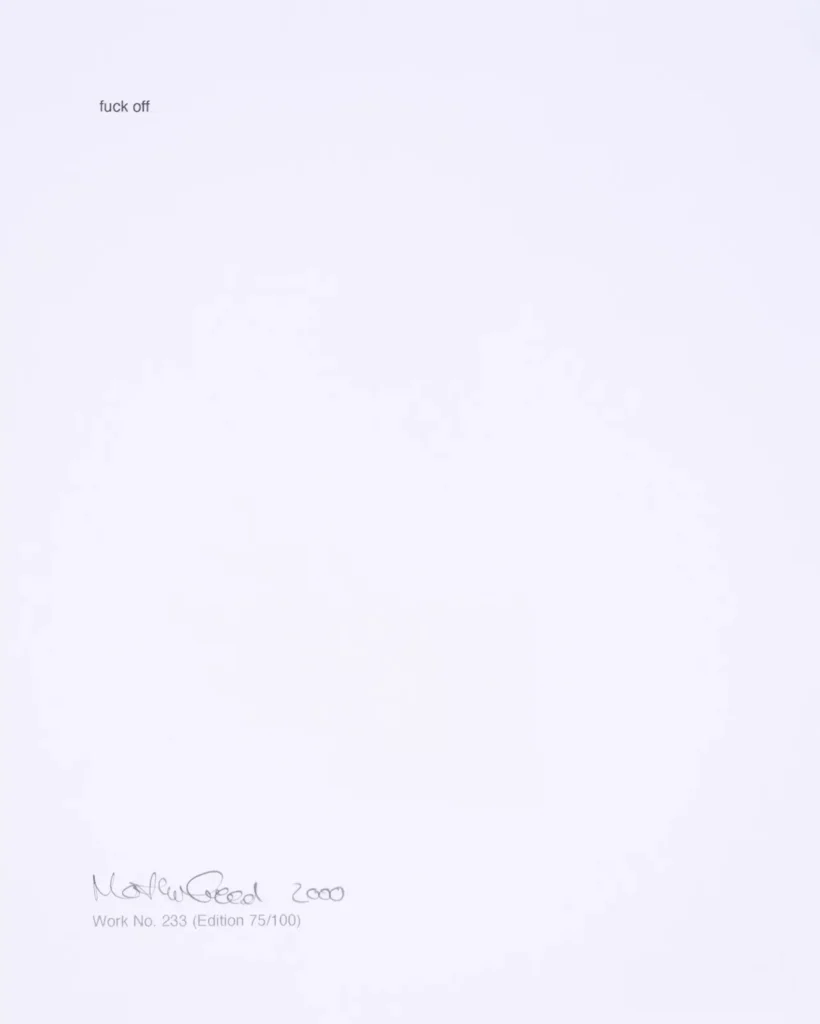In the field of conceptual art, few artists have captured the paradoxical combination of simplicity and provocation quite like Martin Creed. His Work No. 233, from Cubitt Print Box (2000) — a minimal inkjet print that features the curt, dismissive phrase “fuck off” floating in a sea of white space — stands as one of the boldest and most deceptively straightforward works in contemporary British art.
At first glance, it may seem like a juvenile provocation or a simple joke. Yet, as with much of Creed’s work, beneath the superficial layer lies a deep interrogation of language, authorship, art as commodity, and the psychological relationship between viewer and object.
The Artist: Martin Creed and His Conceptual Lexicon
Born in 1968 in Wakefield, England, and raised in Glasgow, Martin Creed emerged in the 1990s as one of the key figures in British conceptual art. Creed’s practice defies easy categorization, often revolving around minimalist gestures, ordinary materials, and a wry, sometimes absurd sense of humor.
Creed rose to international prominence after winning the Turner Prize in 2001 with Work No. 227: The lights going on and off, a piece consisting simply of an empty room in which the lights periodically switch between on and off. This seemingly banal act, like much of his oeuvre, challenges the fundamental definitions of art — questioning what it means to create, to display, and to observe.
Work No. 233 belongs to this same conceptual lineage, distilling Creed’s interests into perhaps their most succinct and confrontational form.
The Power of Language: Two Words, Infinite Ideation
“Fuck off.” Two words that contain a universe of meanings. In Creed’s print, these words float alone, typed in a small font on a large sheet of white paper, rendered via inkjet.
This minimalism is not merely aesthetic. By isolating the phrase, Creed forces us to focus on its cultural and emotional potency. The phrase can be read as aggression, humor, dismissal, liberation, or even invitation to self-reflection. It confronts the viewer directly and intimately, echoing the raw, unfiltered edge of spontaneous human speech.
It’s crucial to understand that Creed treats language as material. Like paint, clay, or neon, words are tools to sculpt psychological space. In Work No. 233, Creed compresses emotional energy into a tiny typographic gesture, subverting the expectations of what an “art print” is supposed to deliver.
Minimalism Meets Punk: The British Context
Conceptual minimalism has deep roots in the 20th century, with artists like Sol LeWitt, Lawrence Weiner, and Joseph Kosuth using language as primary material. Creed’s work aligns with this tradition but injects a peculiarly British irreverence — an echo of punk’s anarchic spirit.
The late 1970s punk movement rejected elaborate, polished rock music in favor of short, abrasive statements. Creed’s print captures that same sense of raw directness. By presenting such a phrase in the refined context of a gallery or private collection, he collapses the divide between high and low culture.
The phrase “fuck off” also plays with the British cultural love of undercutting pretension. In a country obsessed with class and decorum, such a blunt expression becomes a powerful subversion — a reminder that art need not be precious or elitist to be meaningful.
The Physical Object: Materiality and Presence
Work No. 233 is an inkjet print, part of the Cubitt Print Box series released in 2000. Each edition is signed and numbered, turning a profane phrase into a collectible art object.
Here, Creed deftly exposes the commodification of conceptual art. By transforming a simple, offensive text into a limited edition piece, he highlights the tension between art as a conceptual idea and art as a tradable good.
The emptiness of the surrounding space further enhances the phrase’s resonance. The white expanse is not simply “empty” — it is a void that amplifies the viewer’s reaction, a psychological canvas that reflects back the meaning we bring to it.
Audience Reaction: Humor, Discomfort, and Reflection
The immediate reaction to Work No. 233 often oscillates between laughter and discomfort. Some see it as a tongue-and-cheek joke at the art world’s expense. Others feel personally affronted, as if the print were verbally assaulting them.
This ambiguity is central to Creed’s practice. He repeatedly invites the viewer to complete the work through personal interpretation. As he once remarked, “The whole world is one big sculpture and everything matters.” By presenting a simple phrase stripped of context, he encourages us to question our assumptions about civility, communication, and the role of art.
Historical Echoes: Language in Conceptual Art
Creed’s use of text echoes earlier conceptual pioneers. Lawrence Weiner’s declarative wall statements — such as “A 36″ x 36″ removal to the lathing or support wall of plaster or wallboard from a wall” — transformed simple text into sculpture. Jenny Holzer’s inflammatory LED truisms (“Abuse of power comes as no surprise”) likewise used language as a weapon against complacency.
However, Creed’s approach is even more stripped-down, using minimal language to maximal psychological effect. Where Holzer addresses systemic structures, Creed often turns the lens inward, confronting individual emotion and reaction.
Recent Trends: The Rise of Text-Based Art
Over the past two decades, text-based artworks have experienced a renaissance in the art market and public imagination. From street art to Instagram-friendly installations, short phrases have become a dominant medium for direct, shareable impact.
In an era of shrinking attention spans and social media soundbites, Creed’s work feels prescient. Work No. 233 predates the hashtag era but anticipates the meme-like power of brief, viral statements.
Moreover, the minimalist aesthetic aligns with contemporary design trends, which favor clarity and brevity. Collectors and institutions have increasingly embraced text pieces for their intellectual provocations and visual versatility.
Legacy and Continued Influence
More than two decades since its creation, Work No. 233 remains a lightning rod for discussion. Museums and private collectors continue to acquire it, not just as a piece of 2000s conceptual art history but as a living, challenging statement that resonates with each new generation.
Creed himself has continued to evolve, working across media — including sculpture, music, performance, and large-scale installations. Yet, Work No. 233 persists as a distilled emblem of his practice: unassuming in appearance, deeply provocative in content.
Impression
At its core, Work No. 233 exemplifies Creed’s genius for merging minimalism with emotional immediacy. It is at once a literal insult and a conceptual invitation, depending on the viewer’s interpretation.
By transforming an everyday profanity into a rarefied art object, Creed contrives us to confront our own relationships with language, power, and the structures of the art world itself. It is a reminder that sometimes, the most profound statements require the fewest words — or, in this case, two.
Whether you find it hilarious, offensive, or transcendent, Work No. 233 refuses to be ignored. It lives on as a provocative punctuation mark in contemporary art’s ongoing dialogue — one that keeps us questioning, laughing, and perhaps, just maybe, telling it (or each other) to “fuck off.”
No comments yet.








